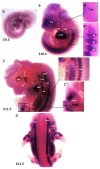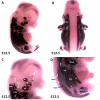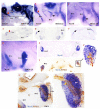The Emergence of Embryonic Myosin Heavy Chain during Branchiomeric Muscle Development
- PMID: 35743816
- PMCID: PMC9224566
- DOI: 10.3390/life12060785
The Emergence of Embryonic Myosin Heavy Chain during Branchiomeric Muscle Development
Abstract
A prerequisite for discovering the properties and therapeutic potential of branchiomeric muscles is an understanding of their fate determination, pattering and differentiation. Although the expression of differentiation markers such as myosin heavy chain (MyHC) during trunk myogenesis has been more intensively studied, little is known about its expression in the developing branchiomeric muscle anlagen. To shed light on this, we traced the onset of MyHC expression in the facial and neck muscle anlagen by using the whole-mount in situ hybridization between embryonic days E9.5 and E15.5 in the mouse. Unlike trunk muscle, the facial and neck muscle anlagen express MyHC at late stages. Within the branchiomeric muscles, our results showed variation in the emergence of MyHC expression. MyHC was first detected in the first arch-derived muscle anlagen, while its expression in the second arch-derived muscle and non-somitic neck muscle began at a later time point. Additionally, we show that non-ectomesenchymal neural crest invasion of the second branchial arch is delayed compared with that of the first brachial arch in chicken embryos. Thus, our findings reflect the timing underlying branchiomeric muscle differentiation.
Keywords: MyHC; branchiomeric muscles; chicken embryos; mouse embryos; neck muscles; non-ectomesenchymal crest cells.
Conflict of interest statement
The authors declare that the research was conducted in the absence of any commercial or financial relationships that could be construed as a potential conflict of interest.
Figures





Similar articles
-
New Insights into the Diversity of Branchiomeric Muscle Development: Genetic Programs and Differentiation.Biology (Basel). 2022 Aug 22;11(8):1245. doi: 10.3390/biology11081245. Biology (Basel). 2022. PMID: 36009872 Free PMC article. Review.
-
Differentiation of avian craniofacial muscles: I. Patterns of early regulatory gene expression and myosin heavy chain synthesis.Dev Dyn. 1999 Oct;216(2):96-112. doi: 10.1002/(SICI)1097-0177(199910)216:2<96::AID-DVDY2>3.0.CO;2-6. Dev Dyn. 1999. PMID: 10536051
-
Branchiomeric Muscle Development Requires Proper Retinoic Acid Signaling.Front Cell Dev Biol. 2021 Jul 9;9:596838. doi: 10.3389/fcell.2021.596838. eCollection 2021. Front Cell Dev Biol. 2021. PMID: 34307338 Free PMC article.
-
The del22q11.2 candidate gene Tbx1 regulates branchiomeric myogenesis.Hum Mol Genet. 2004 Nov 15;13(22):2829-40. doi: 10.1093/hmg/ddh304. Epub 2004 Sep 22. Hum Mol Genet. 2004. PMID: 15385444
-
The CXCR4/SDF-1 Axis in the Development of Facial Expression and Non-somitic Neck Muscles.Front Cell Dev Biol. 2020 Dec 22;8:615264. doi: 10.3389/fcell.2020.615264. eCollection 2020. Front Cell Dev Biol. 2020. PMID: 33415110 Free PMC article. Review.
Cited by
-
New Insights into the Diversity of Branchiomeric Muscle Development: Genetic Programs and Differentiation.Biology (Basel). 2022 Aug 22;11(8):1245. doi: 10.3390/biology11081245. Biology (Basel). 2022. PMID: 36009872 Free PMC article. Review.
References
Grants and funding
LinkOut - more resources
Full Text Sources

